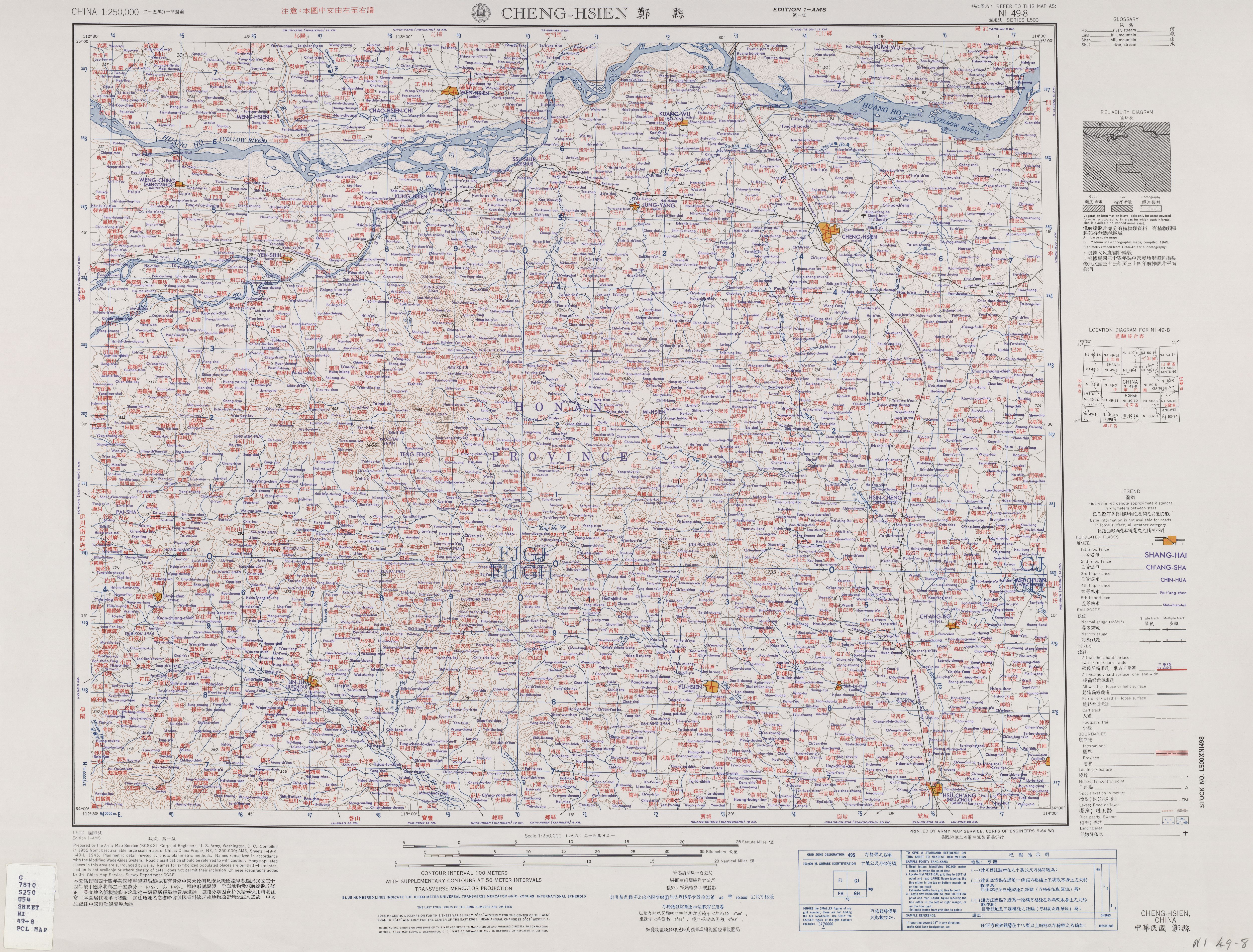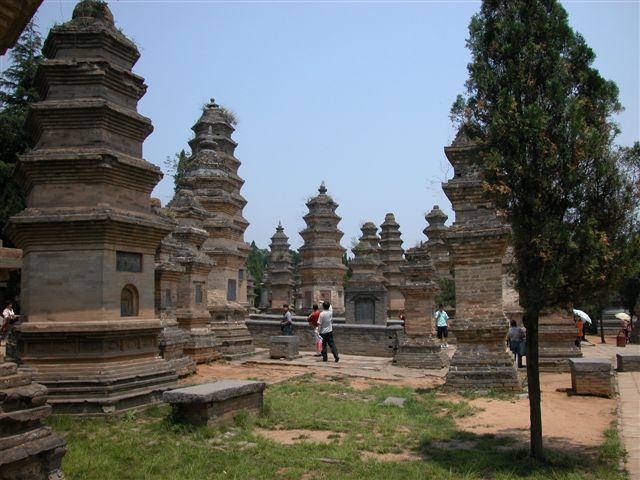|
Dengfeng
Dengfeng (; postal: Tengfeng) is a county-level city of Henan Province, China. It is under the administration of the prefecture-level city of Zhengzhou. Dengfeng has an area of and a population of 630,000. It occupies the southwestern corner of Zhengzhou and is its westernmost county-level division. Dengfeng is located at the foot of the Mount Song, one of the most sacred mountains in China. The city is one of the most renowned spiritual centers of China, and is home to various religious institutions and famous temples such as the Taoist Zhongyue Temple, the Buddhist Shaolin Temple (a renowned center for martial arts), as well as the Confucian Songyang Academy and the Gaocheng Observatory, hence its poetic expression derived from Chinese literature as the spiritual "center of heaven and earth". Parts of the city were inscribed on the UNESCO World Heritage List in 2010. History The first Xia dynasty capital, Yangcheng, was built west of Gaocheng Township on the Ying River u ... [...More Info...] [...Related Items...] OR: [Wikipedia] [Google] [Baidu] |
Chuzu Temple
Dengfeng (; Postal romanization, postal: Tengfeng) is a county-level city of Henan, Henan Province, China. It is under the administration of the prefecture-level city of Zhengzhou. Dengfeng has an area of and a population of 630,000. It occupies the southwestern corner of Zhengzhou and is its westernmost county-level division. Dengfeng is located at the foot of the Mount Song, one of the most sacred mountains in China. The city is one of the most renowned spiritual centers of China, and is home to various religious institutions and famous temples such as the Taoist Zhongyue Temple, the Buddhist Shaolin Temple (a renowned center for martial arts), as well as the Confucian Songyang Academy and the Gaocheng Astronomical Observatory, Gaocheng Observatory, hence its poetic expression derived from Chinese literature as the spiritual "center of heaven and earth". Parts of the city were inscribed on the UNESCO World Heritage List in 2010. History The first Xia dynasty capital, Yangche ... [...More Info...] [...Related Items...] OR: [Wikipedia] [Google] [Baidu] |
Mount Song
Mount Song (, "lofty mountain") is an isolated mountain range in north central China's Henan Province, along the southern bank of the Yellow River. It is known in literary and folk tradition as the central mountain of the Five Great Mountains of China. Since at least as early as the early 1st millennium BC, Chinese astronomical mythology had acquired the idea that Mount Song is "the centre of Heaven and Earth." It was respected as such by the successive dynasties of the Chinese Empire. The name Songshan also applies to a peak of the range located at , elevation . It is the 4th highest peak, but second in prominence at . Songshan National Scenic Spot is named after it. The highest peak in the range is Lian Tian Feng at , also most prominent at . It is located at the coordinates shown for the article. On its upper slopes is the Sanhuangzhai Scenic Spot, further west seen from Route G1516 (Yanluo Expressway), which skirts the range on the south. The location is across the Shaoyang v ... [...More Info...] [...Related Items...] OR: [Wikipedia] [Google] [Baidu] |
Shaolin Temple
Shaolin Monastery ( zh, labels=no, c=少林寺, p=shàolínsì), also known as Shaolin Temple, is a monastic institution recognized as the birthplace of Chan Buddhism and the cradle of Shaolin kung fu. It is located at the foot of Wuru Peak of the Mount Song, Songshan mountain range in Dengfeng county, Zhengzhou prefecture, in Henan province, China. The name reflects its location in the ancient grove () of Mount Shaoshi, in the hinterland of the Songshan mountains. Mount Song occupied a prominent position among Chinese sacred mountains as early as the 1st century BC, when it was proclaimed one of the Sacred Mountains of China#The Five Great Mountains, Five Holy Peaks (). It is located some southeast of Luoyang, the former capital of the Northern Wei Dynasty (386–534), and southwest of Zhengzhou, the modern capital of Henan Province. As the first Shaolin abbot, Buddhabhadra (Shaolin abbot), Butuo Buddhabhadra devoted himself to translating Buddhist scriptures and preaching ... [...More Info...] [...Related Items...] OR: [Wikipedia] [Google] [Baidu] |
Gaocheng Astronomical Observatory
Gaocheng Astronomical Observatory, also known as the Dengfeng Observatory, is an observatory in Duke of Zhou's shrine, Gaocheng Town, near Dengfeng in Henan province, China. This site has a long tradition of astronomical observations, from the time of the Western Zhou up to the early Yuan dynasty. There is also a gnomon used for the Da Yan calendar in 729 AD and the great observatory of the Yuan dynasty. As part of the "Dengfeng Historic Monuments of Dengfeng 'in the Center of Heaven and Earth'" the observatory was listed as a UNESCO World Heritage Site in 2010. History Western Zhou It is believed that the Duke of Zhou (''c.'' 1042 BC) had erected at this place a ''Ceyingtai'' (observatory measuring the shade or gnomon) to observe the Sun, as he believed the area to be the centre of heaven and earth. His interest in mathematics, astronomy/astrology is reported in the Zhoubi Suanjing. Tang dynasty The astronomer Yi Xing (683–727) of the Tang dynasty built 20 standardized gno ... [...More Info...] [...Related Items...] OR: [Wikipedia] [Google] [Baidu] |
Zhengzhou
Zhengzhou is the capital of Henan, China. Located in northern Henan, it is one of the nine National central city, national central cities in China, and serves as the political, economic, technological, and educational center of the province. The Zhengzhou metropolitan area (including Zhengzhou and Kaifeng) is the core area of the Central Plains Economic Zone. The city lies on the southern bank of the Yellow River. Zhengzhou is a major hub of China's domestic and international transportation network; for example, it is connected to Europe and has an international airport. Zhengzhou is a National Civilized City and a List of National Famous Historical and Cultural Cities in China, State-list Famous Historical and Culture City. As of 2020, there are two List of World Heritage Sites in China, World Cultural Heritage Sites in Zhengzhou. The Zhengzhou Commodity Exchange (ZCE) is China's first futures exchange. Zhengzhou Airport Economy Zone is China's first Airport Economy Zone. As o ... [...More Info...] [...Related Items...] OR: [Wikipedia] [Google] [Baidu] |
Songye Temple Pagoda
The Songyue Pagoda (), constructed in 523 CE, is located at the Songyue Monastery on Mount Song, in Henan province, China.Yetts, 124. Built during the Northern Wei Dynasty, this pagoda is one of the few intact sixth-century pagodas in China and is also the earliest known Chinese brick pagoda. Most structures from that period were made of wood and have not survived, although ruins of rammed earth fortifications still exist. In 2010, the Pagoda was inscribed on the UNESCO World Heritage List along with other nearby monuments as part of the ' Historic Monuments of Dengfeng in “The Centre of Heaven and Earth” site. Background The spread of Buddhism dramatically influenced Chinese architecture. By the sixth century, Buddhism had spread with tremendous momentum throughout China: Chinese culture was adjusting and adapting its traditions to include Buddhism worship. The Chinese transformed the rounded earthen mound of the South Asian stupa into the towering pagoda to house the sacr ... [...More Info...] [...Related Items...] OR: [Wikipedia] [Google] [Baidu] |
Henan
Henan; alternatively Honan is a province in Central China. Henan is home to many heritage sites, including Yinxu, the ruins of the final capital of the Shang dynasty () and the Shaolin Temple. Four of the historical capitals of China, Luoyang, Anyang, Kaifeng and Zhengzhou, are in Henan. While the province's name means 'south of the river', approximately a quarter of the province lies north of the Yellow River. With an area of , Henan covers a large part of the fertile and densely populated North China Plain. Its neighboring provinces are Shaanxi, Shanxi, Hebei, Shandong, Anhui, and Hubei. Henan is China's third-most populous province and the most populous among inland provinces, with a population of over 99 million as of 2020. It is also the world's seventh-most populous administrative division; if it were a country by itself, Henan would be the 17th-most populous in the world, behind Egypt and Vietnam. People from Henan often suffer from regional discrimination ... [...More Info...] [...Related Items...] OR: [Wikipedia] [Google] [Baidu] |
Xia Dynasty
The Xia dynasty (; ) is the first dynasty in traditional Chinese historiography. According to tradition, it was established by the legendary figure Yu the Great, after Emperor Shun, Shun, the last of the Three Sovereigns and Five Emperors, Five Emperors, gave the throne to him. In traditional historiography, the Xia was succeeded by the Shang dynasty. There are no contemporaneous records of the Xia, and they are not mentioned in the oldest Chinese texts, the earliest oracle bone inscriptions dating from the Late Shang period (13th century BC). The earliest mentions occur in the oldest chapters of the ''Book of Documents'', which report speeches from the early Western Zhou period and are accepted by most scholars as dating from that time. The speeches justify the Zhou conquest of the Shang as the passing of the Mandate of Heaven and liken it to the succession of the Xia by the Shang. That political philosophy was promoted by the Confucian school in the Eastern Zhou period. ... [...More Info...] [...Related Items...] OR: [Wikipedia] [Google] [Baidu] |
Pagoda Forest
Pagoda Forest at Shaolin Temple refers to the main cemetery for Buddhist monks at the Shaolin Temple under Mount Song. Consisting of about 250 memorial pagodas beneath or in which the ashes of the deceased were placed, the cemetery covers about . The cemetery is forested. Its name, "tower forest" reflects that fact, whether because the pagodas are like a forest, or are in a forest. The usual English translation is "Pagoda Forest." Its center is about from monastery grounds. These memorial "pagodas" are not real ones, which are inhabitable buildings of one or more stories with roofs bearing upturned eaves. Symbolically the memorial imitations are habitations of the dead, representing real towers. In English the upturned roofs are often termed "tiers." The number of tiers in the memorial tower are compatible with the former status of the deceased. The continuity covers more than 1,200 years, but usage continues at a slow rate. Not every monk can be interred there; for the most ... [...More Info...] [...Related Items...] OR: [Wikipedia] [Google] [Baidu] |
County-level City
A county-level city () is a County-level divisions of China, county-level administrative division of the China, People's Republic of China. County-level cities have judiciary, judicial but no legislature, legislative rights over their own local ordinance, local law and are usually governed by Administrative divisions of China#Prefectural level (2nd), prefecture-level divisions, but a few are governed directly by Administrative divisions of China#Provincial level (1st), province-level divisions. A county-level city is a "city" () and "county" () that have been merged into one unified jurisdiction. As such, it is simultaneously a city, which is a municipal entity, and a county, which is an administrative division of a prefecture. Most county-level cities were created in the 1980s and 1990s by replacing denser populated Counties of China, counties. County-level cities are not "city, cities" in the strictest sense of the word, since they usually contain rural areas many times the size ... [...More Info...] [...Related Items...] OR: [Wikipedia] [Google] [Baidu] |







